Clinical Reasoning Cycle for Nursing Care: A Case Study
VerifiedAdded on 2023/06/07
|9
|2383
|410
AI Summary
This essay outlines the care decision making, care planning and implementation procedure of a patient named Denise Palmer taking the assistance of a case study. It explores the steps of clinical reasoning cycle in care planning and implementation in caring for a cardiac emergency of a patient. It also discusses the management of vital signs, shortness of breath and infection control.
Contribute Materials
Your contribution can guide someone’s learning journey. Share your
documents today.
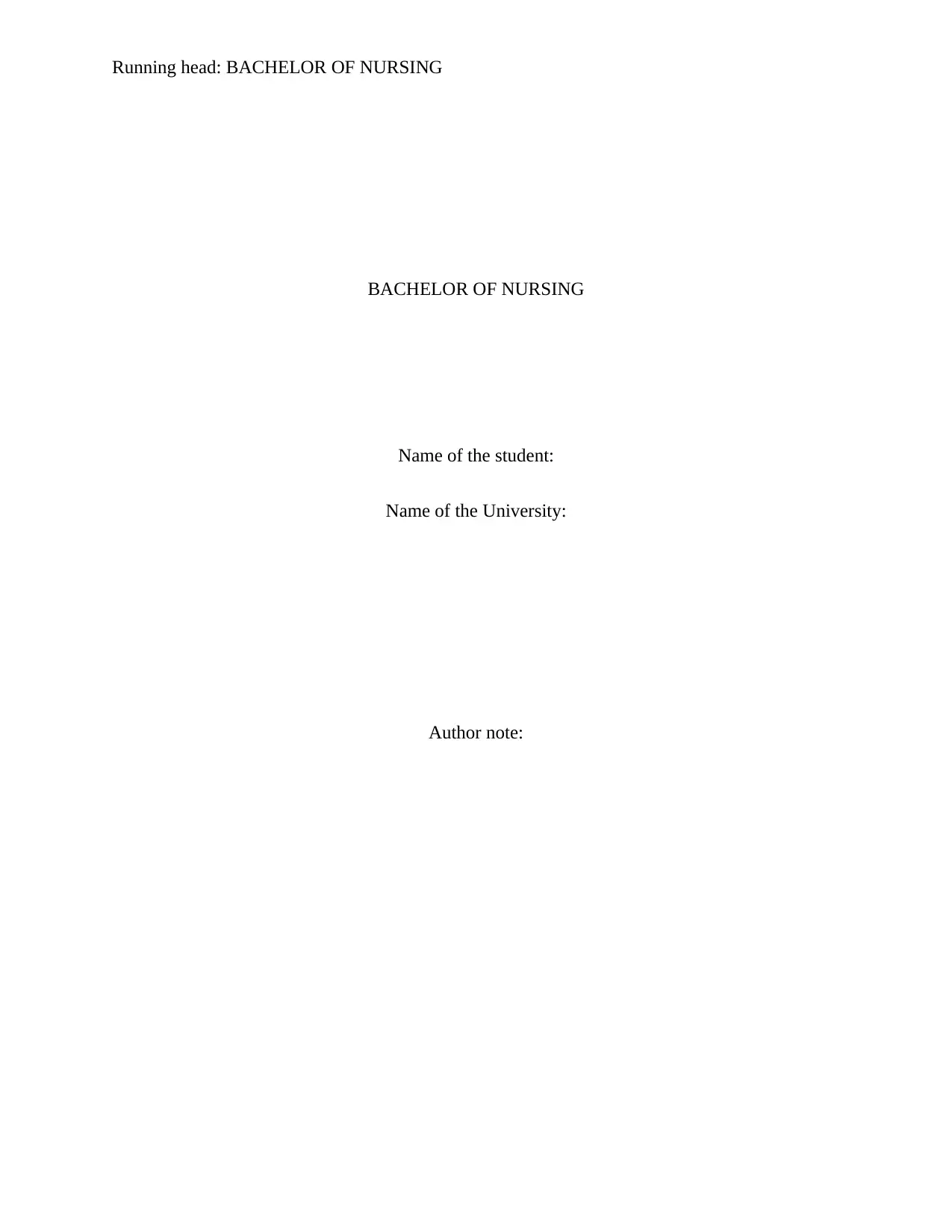
Running head: BACHELOR OF NURSING
BACHELOR OF NURSING
Name of the student:
Name of the University:
Author note:
BACHELOR OF NURSING
Name of the student:
Name of the University:
Author note:
Secure Best Marks with AI Grader
Need help grading? Try our AI Grader for instant feedback on your assignments.
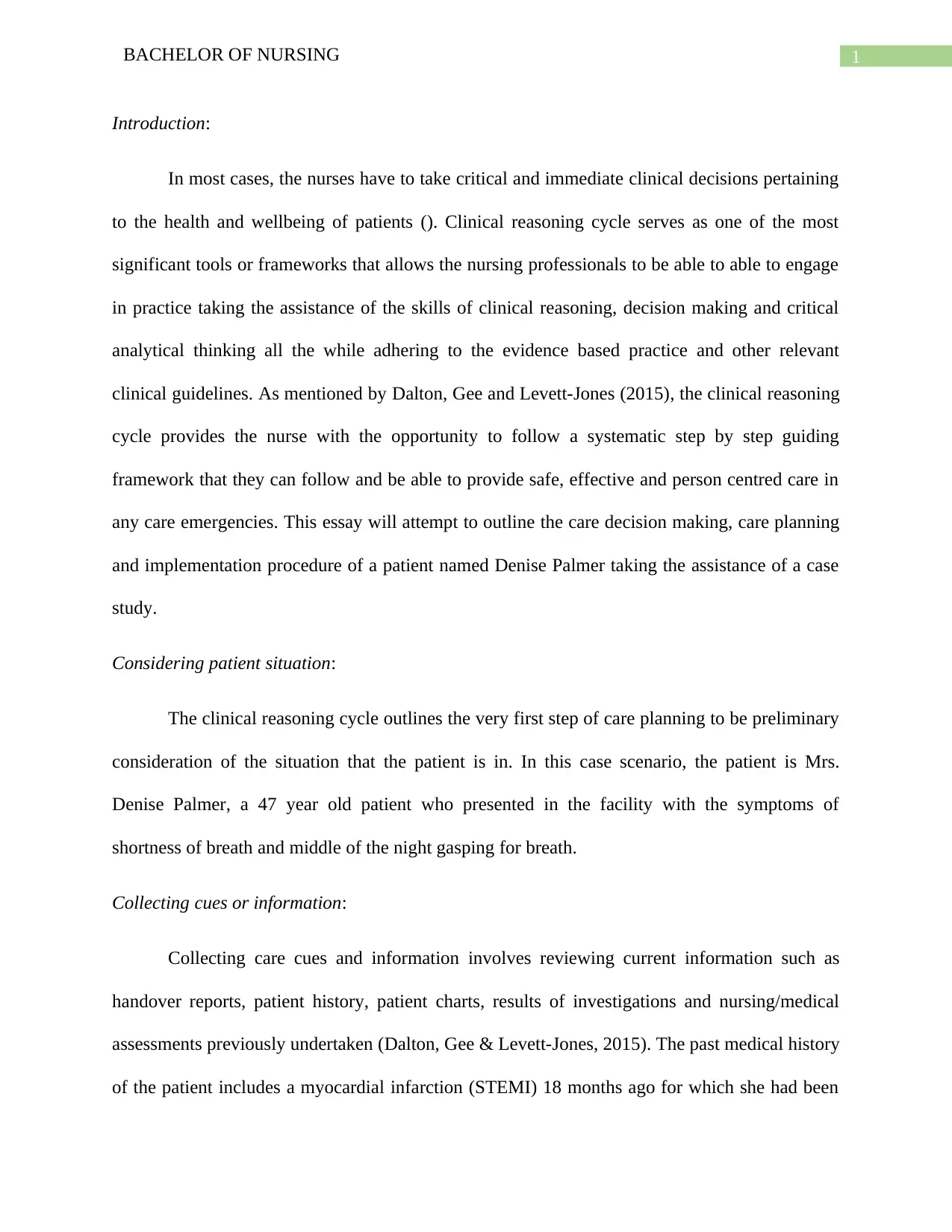
1BACHELOR OF NURSING
Introduction:
In most cases, the nurses have to take critical and immediate clinical decisions pertaining
to the health and wellbeing of patients (). Clinical reasoning cycle serves as one of the most
significant tools or frameworks that allows the nursing professionals to be able to able to engage
in practice taking the assistance of the skills of clinical reasoning, decision making and critical
analytical thinking all the while adhering to the evidence based practice and other relevant
clinical guidelines. As mentioned by Dalton, Gee and Levett-Jones (2015), the clinical reasoning
cycle provides the nurse with the opportunity to follow a systematic step by step guiding
framework that they can follow and be able to provide safe, effective and person centred care in
any care emergencies. This essay will attempt to outline the care decision making, care planning
and implementation procedure of a patient named Denise Palmer taking the assistance of a case
study.
Considering patient situation:
The clinical reasoning cycle outlines the very first step of care planning to be preliminary
consideration of the situation that the patient is in. In this case scenario, the patient is Mrs.
Denise Palmer, a 47 year old patient who presented in the facility with the symptoms of
shortness of breath and middle of the night gasping for breath.
Collecting cues or information:
Collecting care cues and information involves reviewing current information such as
handover reports, patient history, patient charts, results of investigations and nursing/medical
assessments previously undertaken (Dalton, Gee & Levett-Jones, 2015). The past medical history
of the patient includes a myocardial infarction (STEMI) 18 months ago for which she had been
Introduction:
In most cases, the nurses have to take critical and immediate clinical decisions pertaining
to the health and wellbeing of patients (). Clinical reasoning cycle serves as one of the most
significant tools or frameworks that allows the nursing professionals to be able to able to engage
in practice taking the assistance of the skills of clinical reasoning, decision making and critical
analytical thinking all the while adhering to the evidence based practice and other relevant
clinical guidelines. As mentioned by Dalton, Gee and Levett-Jones (2015), the clinical reasoning
cycle provides the nurse with the opportunity to follow a systematic step by step guiding
framework that they can follow and be able to provide safe, effective and person centred care in
any care emergencies. This essay will attempt to outline the care decision making, care planning
and implementation procedure of a patient named Denise Palmer taking the assistance of a case
study.
Considering patient situation:
The clinical reasoning cycle outlines the very first step of care planning to be preliminary
consideration of the situation that the patient is in. In this case scenario, the patient is Mrs.
Denise Palmer, a 47 year old patient who presented in the facility with the symptoms of
shortness of breath and middle of the night gasping for breath.
Collecting cues or information:
Collecting care cues and information involves reviewing current information such as
handover reports, patient history, patient charts, results of investigations and nursing/medical
assessments previously undertaken (Dalton, Gee & Levett-Jones, 2015). The past medical history
of the patient includes a myocardial infarction (STEMI) 18 months ago for which she had been
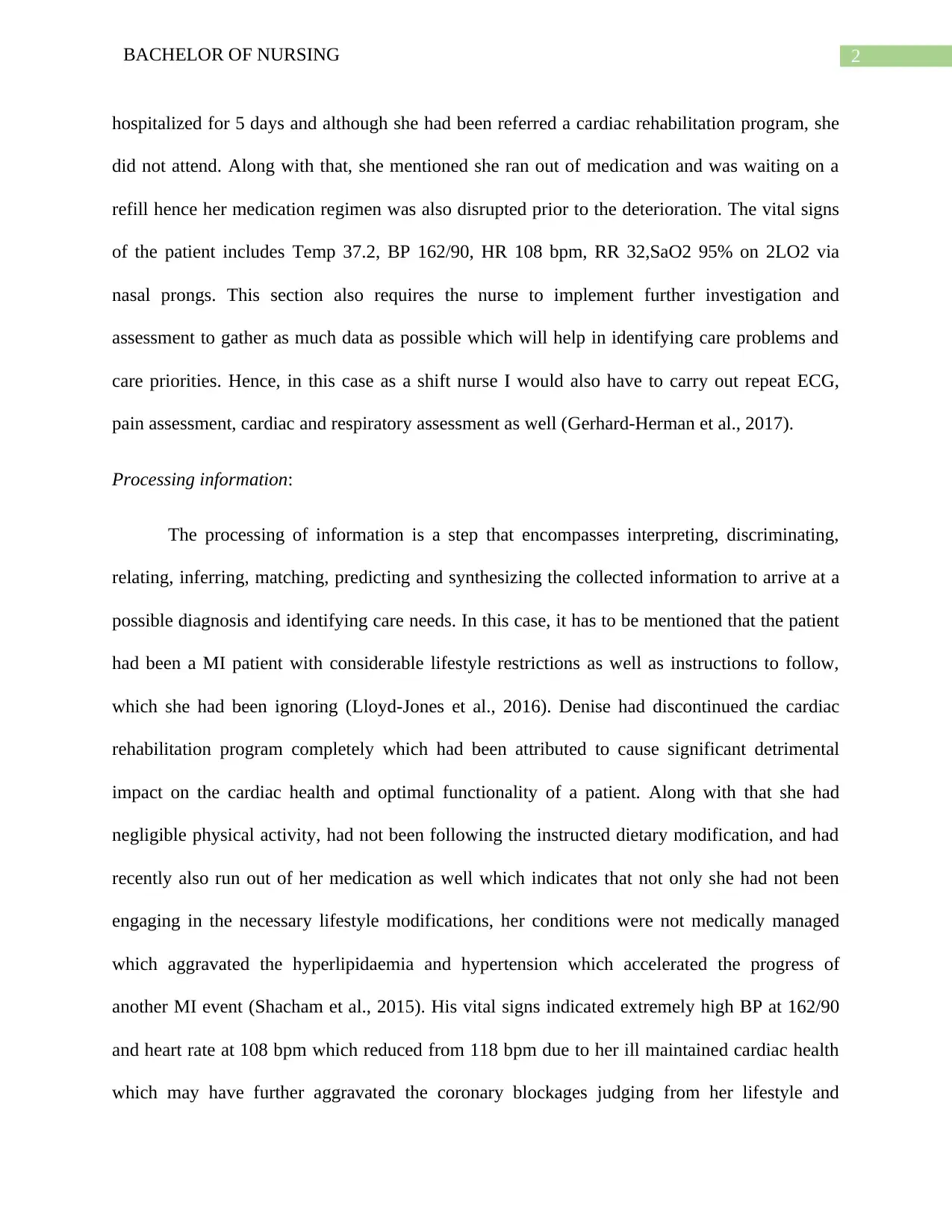
2BACHELOR OF NURSING
hospitalized for 5 days and although she had been referred a cardiac rehabilitation program, she
did not attend. Along with that, she mentioned she ran out of medication and was waiting on a
refill hence her medication regimen was also disrupted prior to the deterioration. The vital signs
of the patient includes Temp 37.2, BP 162/90, HR 108 bpm, RR 32,SaO2 95% on 2LO2 via
nasal prongs. This section also requires the nurse to implement further investigation and
assessment to gather as much data as possible which will help in identifying care problems and
care priorities. Hence, in this case as a shift nurse I would also have to carry out repeat ECG,
pain assessment, cardiac and respiratory assessment as well (Gerhard-Herman et al., 2017).
Processing information:
The processing of information is a step that encompasses interpreting, discriminating,
relating, inferring, matching, predicting and synthesizing the collected information to arrive at a
possible diagnosis and identifying care needs. In this case, it has to be mentioned that the patient
had been a MI patient with considerable lifestyle restrictions as well as instructions to follow,
which she had been ignoring (Lloyd-Jones et al., 2016). Denise had discontinued the cardiac
rehabilitation program completely which had been attributed to cause significant detrimental
impact on the cardiac health and optimal functionality of a patient. Along with that she had
negligible physical activity, had not been following the instructed dietary modification, and had
recently also run out of her medication as well which indicates that not only she had not been
engaging in the necessary lifestyle modifications, her conditions were not medically managed
which aggravated the hyperlipidaemia and hypertension which accelerated the progress of
another MI event (Shacham et al., 2015). His vital signs indicated extremely high BP at 162/90
and heart rate at 108 bpm which reduced from 118 bpm due to her ill maintained cardiac health
which may have further aggravated the coronary blockages judging from her lifestyle and
hospitalized for 5 days and although she had been referred a cardiac rehabilitation program, she
did not attend. Along with that, she mentioned she ran out of medication and was waiting on a
refill hence her medication regimen was also disrupted prior to the deterioration. The vital signs
of the patient includes Temp 37.2, BP 162/90, HR 108 bpm, RR 32,SaO2 95% on 2LO2 via
nasal prongs. This section also requires the nurse to implement further investigation and
assessment to gather as much data as possible which will help in identifying care problems and
care priorities. Hence, in this case as a shift nurse I would also have to carry out repeat ECG,
pain assessment, cardiac and respiratory assessment as well (Gerhard-Herman et al., 2017).
Processing information:
The processing of information is a step that encompasses interpreting, discriminating,
relating, inferring, matching, predicting and synthesizing the collected information to arrive at a
possible diagnosis and identifying care needs. In this case, it has to be mentioned that the patient
had been a MI patient with considerable lifestyle restrictions as well as instructions to follow,
which she had been ignoring (Lloyd-Jones et al., 2016). Denise had discontinued the cardiac
rehabilitation program completely which had been attributed to cause significant detrimental
impact on the cardiac health and optimal functionality of a patient. Along with that she had
negligible physical activity, had not been following the instructed dietary modification, and had
recently also run out of her medication as well which indicates that not only she had not been
engaging in the necessary lifestyle modifications, her conditions were not medically managed
which aggravated the hyperlipidaemia and hypertension which accelerated the progress of
another MI event (Shacham et al., 2015). His vital signs indicated extremely high BP at 162/90
and heart rate at 108 bpm which reduced from 118 bpm due to her ill maintained cardiac health
which may have further aggravated the coronary blockages judging from her lifestyle and

3BACHELOR OF NURSING
obesity statistics at 87 kg weight and >30 BMI. Along with that the high respiratory rate at RR
32 and low oxygen saturation at 95% indicates at the inefficient pulmonary circulation and fluid
back up (Stevenson et al., 2016). Along with her deteriorating and infected leg ulcer indicates the
probability of type two diabetes, which could have further aggravated her cardiac health and
overall vitals as well (Agale, 2013).
Identifying problems and care priorities:
As per the information processed, there are various care needs exhibited by Denise, such
as shortness of breath resulting from the deteriorating respiratory distress, tachycardia and
hypertension due to enhanced cardiac load, rising body temperature due to disrupted
haemodynamic stability in the body, imbalance in the blood glucose levels and the infected and
deteriorating leg ulcer with pus discharge and malodour. However, as per the present symptoms,
the most notable care priorities that demand immediate nursing intervention to avoid fatal
consequences or severe exacerbation event include shortness of breath and respiratory distress,
tachycardia and hypertension, and wound management and infection control for the leg ulcer
(Chow et al., 2015).
Establishing goals:
In the clinical assessment it has been found that Mrs Palmer has been suffering from
shortness of breath and respiratory rate have increased to 32 bpm. Thus, the first goal would be
to address the breathing problem and reduce the heart rate and respiratory rate to normal rate
(Martin & Grocott, 2013). It has been identified that blood pressure of the patient has increased
to 160/90 and her heart rate has been found to be 108 bpm which has led to the consequence of
obesity statistics at 87 kg weight and >30 BMI. Along with that the high respiratory rate at RR
32 and low oxygen saturation at 95% indicates at the inefficient pulmonary circulation and fluid
back up (Stevenson et al., 2016). Along with her deteriorating and infected leg ulcer indicates the
probability of type two diabetes, which could have further aggravated her cardiac health and
overall vitals as well (Agale, 2013).
Identifying problems and care priorities:
As per the information processed, there are various care needs exhibited by Denise, such
as shortness of breath resulting from the deteriorating respiratory distress, tachycardia and
hypertension due to enhanced cardiac load, rising body temperature due to disrupted
haemodynamic stability in the body, imbalance in the blood glucose levels and the infected and
deteriorating leg ulcer with pus discharge and malodour. However, as per the present symptoms,
the most notable care priorities that demand immediate nursing intervention to avoid fatal
consequences or severe exacerbation event include shortness of breath and respiratory distress,
tachycardia and hypertension, and wound management and infection control for the leg ulcer
(Chow et al., 2015).
Establishing goals:
In the clinical assessment it has been found that Mrs Palmer has been suffering from
shortness of breath and respiratory rate have increased to 32 bpm. Thus, the first goal would be
to address the breathing problem and reduce the heart rate and respiratory rate to normal rate
(Martin & Grocott, 2013). It has been identified that blood pressure of the patient has increased
to 160/90 and her heart rate has been found to be 108 bpm which has led to the consequence of
Secure Best Marks with AI Grader
Need help grading? Try our AI Grader for instant feedback on your assignments.
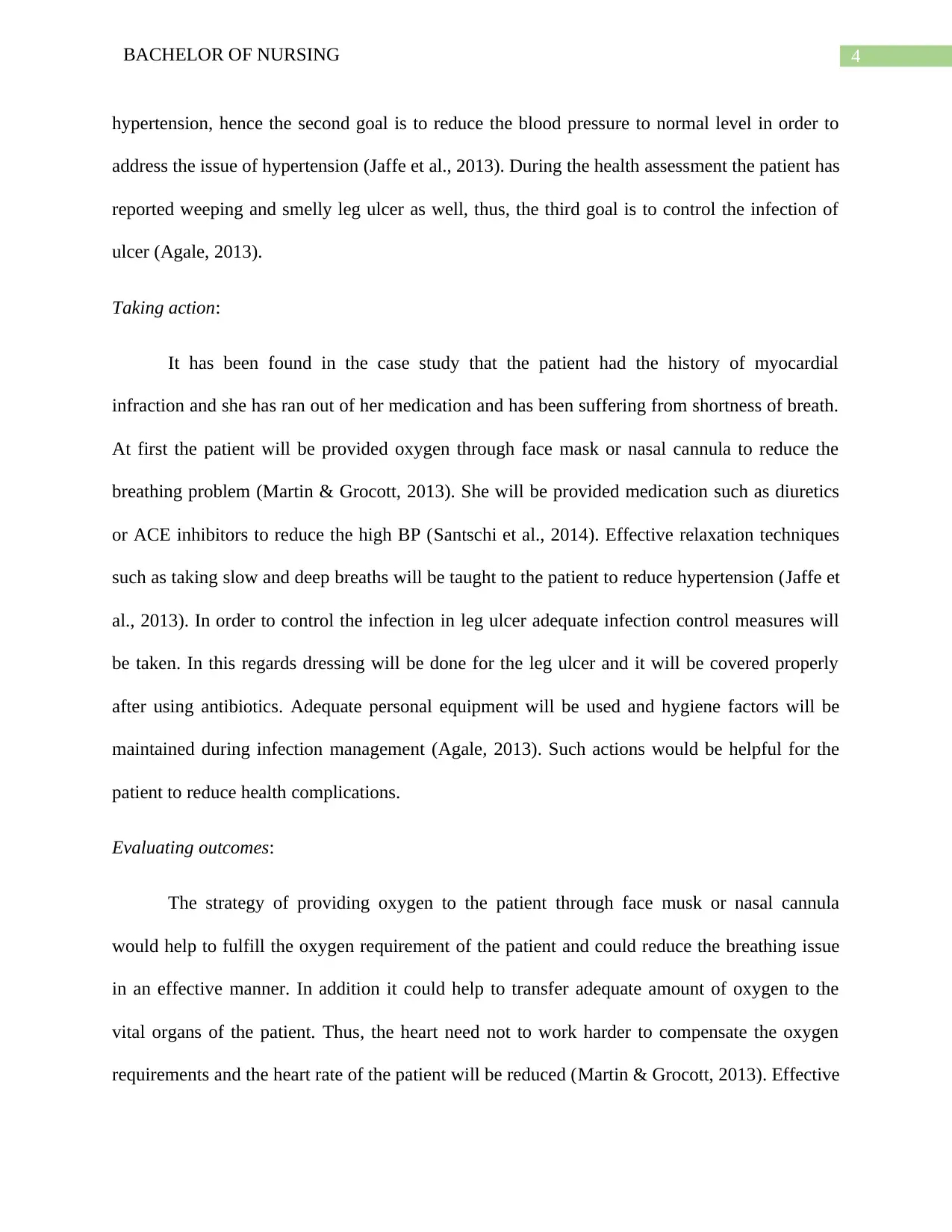
4BACHELOR OF NURSING
hypertension, hence the second goal is to reduce the blood pressure to normal level in order to
address the issue of hypertension (Jaffe et al., 2013). During the health assessment the patient has
reported weeping and smelly leg ulcer as well, thus, the third goal is to control the infection of
ulcer (Agale, 2013).
Taking action:
It has been found in the case study that the patient had the history of myocardial
infraction and she has ran out of her medication and has been suffering from shortness of breath.
At first the patient will be provided oxygen through face mask or nasal cannula to reduce the
breathing problem (Martin & Grocott, 2013). She will be provided medication such as diuretics
or ACE inhibitors to reduce the high BP (Santschi et al., 2014). Effective relaxation techniques
such as taking slow and deep breaths will be taught to the patient to reduce hypertension (Jaffe et
al., 2013). In order to control the infection in leg ulcer adequate infection control measures will
be taken. In this regards dressing will be done for the leg ulcer and it will be covered properly
after using antibiotics. Adequate personal equipment will be used and hygiene factors will be
maintained during infection management (Agale, 2013). Such actions would be helpful for the
patient to reduce health complications.
Evaluating outcomes:
The strategy of providing oxygen to the patient through face musk or nasal cannula
would help to fulfill the oxygen requirement of the patient and could reduce the breathing issue
in an effective manner. In addition it could help to transfer adequate amount of oxygen to the
vital organs of the patient. Thus, the heart need not to work harder to compensate the oxygen
requirements and the heart rate of the patient will be reduced (Martin & Grocott, 2013). Effective
hypertension, hence the second goal is to reduce the blood pressure to normal level in order to
address the issue of hypertension (Jaffe et al., 2013). During the health assessment the patient has
reported weeping and smelly leg ulcer as well, thus, the third goal is to control the infection of
ulcer (Agale, 2013).
Taking action:
It has been found in the case study that the patient had the history of myocardial
infraction and she has ran out of her medication and has been suffering from shortness of breath.
At first the patient will be provided oxygen through face mask or nasal cannula to reduce the
breathing problem (Martin & Grocott, 2013). She will be provided medication such as diuretics
or ACE inhibitors to reduce the high BP (Santschi et al., 2014). Effective relaxation techniques
such as taking slow and deep breaths will be taught to the patient to reduce hypertension (Jaffe et
al., 2013). In order to control the infection in leg ulcer adequate infection control measures will
be taken. In this regards dressing will be done for the leg ulcer and it will be covered properly
after using antibiotics. Adequate personal equipment will be used and hygiene factors will be
maintained during infection management (Agale, 2013). Such actions would be helpful for the
patient to reduce health complications.
Evaluating outcomes:
The strategy of providing oxygen to the patient through face musk or nasal cannula
would help to fulfill the oxygen requirement of the patient and could reduce the breathing issue
in an effective manner. In addition it could help to transfer adequate amount of oxygen to the
vital organs of the patient. Thus, the heart need not to work harder to compensate the oxygen
requirements and the heart rate of the patient will be reduced (Martin & Grocott, 2013). Effective
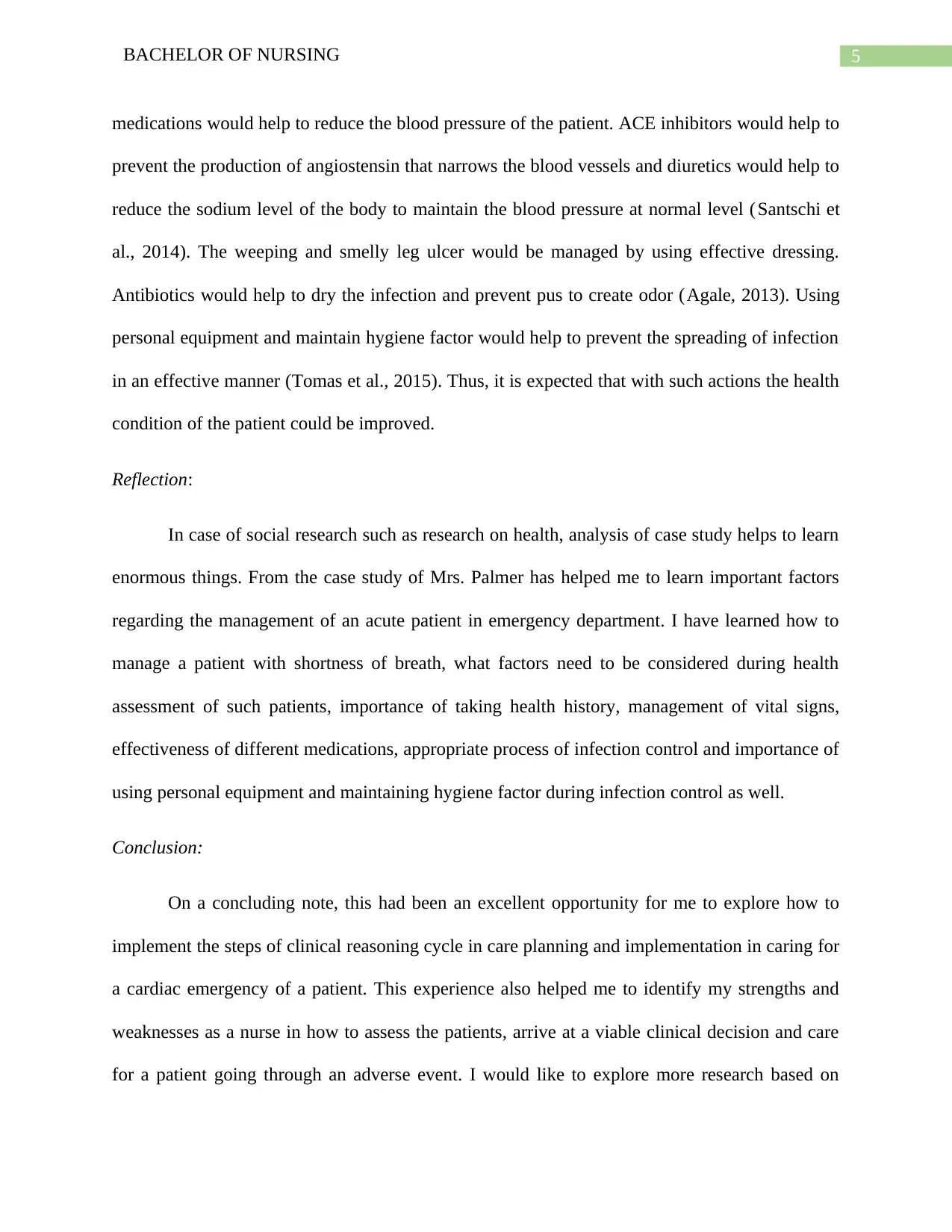
5BACHELOR OF NURSING
medications would help to reduce the blood pressure of the patient. ACE inhibitors would help to
prevent the production of angiostensin that narrows the blood vessels and diuretics would help to
reduce the sodium level of the body to maintain the blood pressure at normal level (Santschi et
al., 2014). The weeping and smelly leg ulcer would be managed by using effective dressing.
Antibiotics would help to dry the infection and prevent pus to create odor (Agale, 2013). Using
personal equipment and maintain hygiene factor would help to prevent the spreading of infection
in an effective manner (Tomas et al., 2015). Thus, it is expected that with such actions the health
condition of the patient could be improved.
Reflection:
In case of social research such as research on health, analysis of case study helps to learn
enormous things. From the case study of Mrs. Palmer has helped me to learn important factors
regarding the management of an acute patient in emergency department. I have learned how to
manage a patient with shortness of breath, what factors need to be considered during health
assessment of such patients, importance of taking health history, management of vital signs,
effectiveness of different medications, appropriate process of infection control and importance of
using personal equipment and maintaining hygiene factor during infection control as well.
Conclusion:
On a concluding note, this had been an excellent opportunity for me to explore how to
implement the steps of clinical reasoning cycle in care planning and implementation in caring for
a cardiac emergency of a patient. This experience also helped me to identify my strengths and
weaknesses as a nurse in how to assess the patients, arrive at a viable clinical decision and care
for a patient going through an adverse event. I would like to explore more research based on
medications would help to reduce the blood pressure of the patient. ACE inhibitors would help to
prevent the production of angiostensin that narrows the blood vessels and diuretics would help to
reduce the sodium level of the body to maintain the blood pressure at normal level (Santschi et
al., 2014). The weeping and smelly leg ulcer would be managed by using effective dressing.
Antibiotics would help to dry the infection and prevent pus to create odor (Agale, 2013). Using
personal equipment and maintain hygiene factor would help to prevent the spreading of infection
in an effective manner (Tomas et al., 2015). Thus, it is expected that with such actions the health
condition of the patient could be improved.
Reflection:
In case of social research such as research on health, analysis of case study helps to learn
enormous things. From the case study of Mrs. Palmer has helped me to learn important factors
regarding the management of an acute patient in emergency department. I have learned how to
manage a patient with shortness of breath, what factors need to be considered during health
assessment of such patients, importance of taking health history, management of vital signs,
effectiveness of different medications, appropriate process of infection control and importance of
using personal equipment and maintaining hygiene factor during infection control as well.
Conclusion:
On a concluding note, this had been an excellent opportunity for me to explore how to
implement the steps of clinical reasoning cycle in care planning and implementation in caring for
a cardiac emergency of a patient. This experience also helped me to identify my strengths and
weaknesses as a nurse in how to assess the patients, arrive at a viable clinical decision and care
for a patient going through an adverse event. I would like to explore more research based on
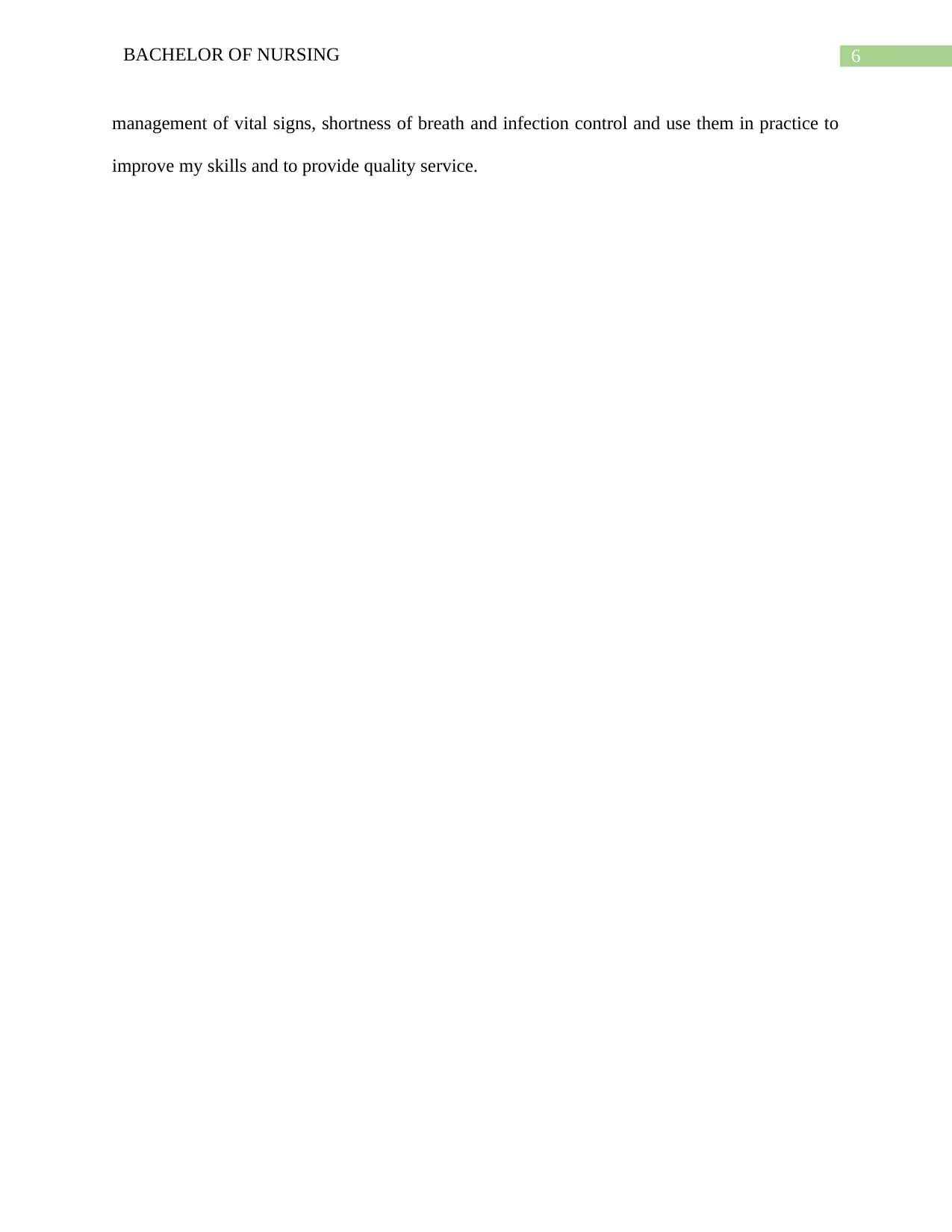
6BACHELOR OF NURSING
management of vital signs, shortness of breath and infection control and use them in practice to
improve my skills and to provide quality service.
management of vital signs, shortness of breath and infection control and use them in practice to
improve my skills and to provide quality service.
Paraphrase This Document
Need a fresh take? Get an instant paraphrase of this document with our AI Paraphraser
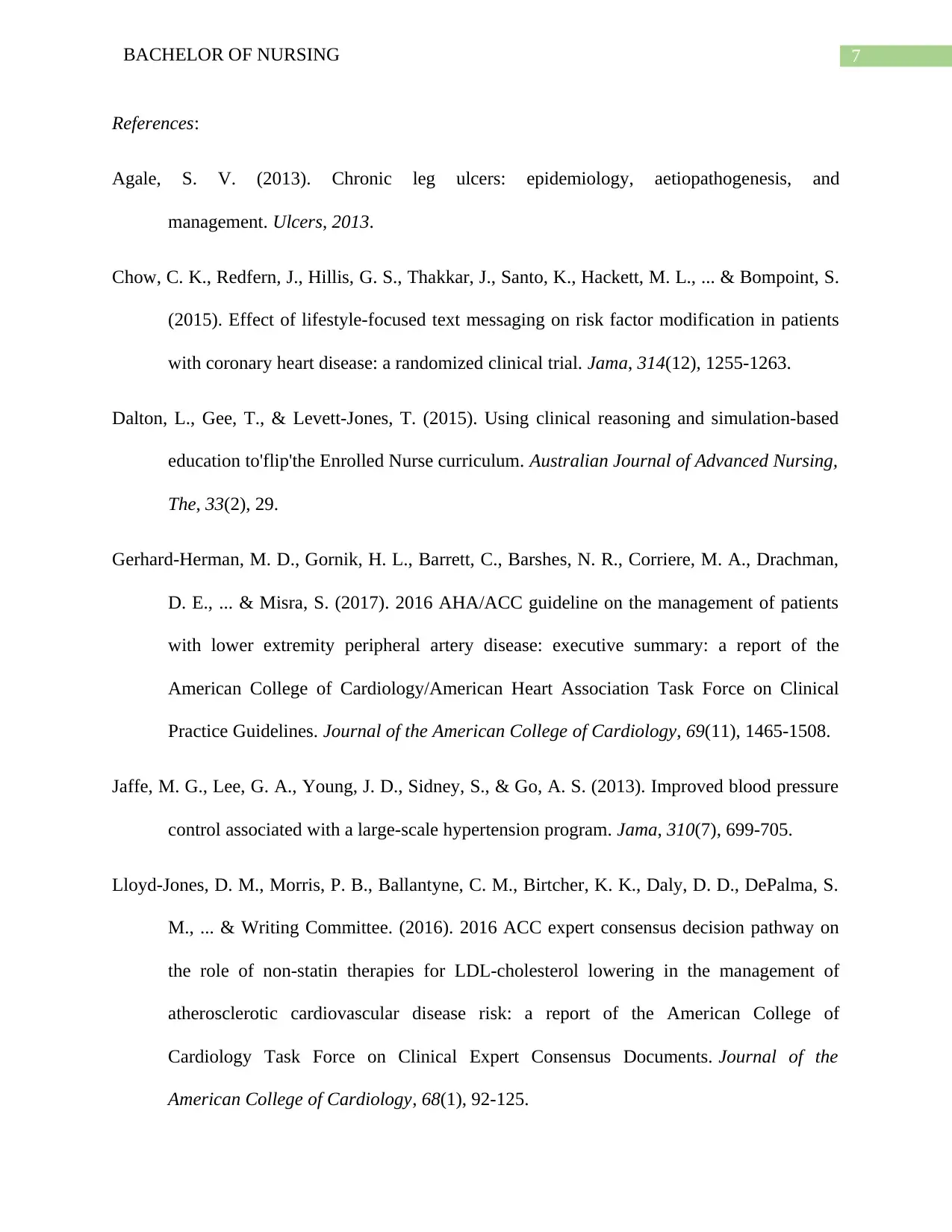
7BACHELOR OF NURSING
References:
Agale, S. V. (2013). Chronic leg ulcers: epidemiology, aetiopathogenesis, and
management. Ulcers, 2013.
Chow, C. K., Redfern, J., Hillis, G. S., Thakkar, J., Santo, K., Hackett, M. L., ... & Bompoint, S.
(2015). Effect of lifestyle-focused text messaging on risk factor modification in patients
with coronary heart disease: a randomized clinical trial. Jama, 314(12), 1255-1263.
Dalton, L., Gee, T., & Levett-Jones, T. (2015). Using clinical reasoning and simulation-based
education to'flip'the Enrolled Nurse curriculum. Australian Journal of Advanced Nursing,
The, 33(2), 29.
Gerhard-Herman, M. D., Gornik, H. L., Barrett, C., Barshes, N. R., Corriere, M. A., Drachman,
D. E., ... & Misra, S. (2017). 2016 AHA/ACC guideline on the management of patients
with lower extremity peripheral artery disease: executive summary: a report of the
American College of Cardiology/American Heart Association Task Force on Clinical
Practice Guidelines. Journal of the American College of Cardiology, 69(11), 1465-1508.
Jaffe, M. G., Lee, G. A., Young, J. D., Sidney, S., & Go, A. S. (2013). Improved blood pressure
control associated with a large-scale hypertension program. Jama, 310(7), 699-705.
Lloyd-Jones, D. M., Morris, P. B., Ballantyne, C. M., Birtcher, K. K., Daly, D. D., DePalma, S.
M., ... & Writing Committee. (2016). 2016 ACC expert consensus decision pathway on
the role of non-statin therapies for LDL-cholesterol lowering in the management of
atherosclerotic cardiovascular disease risk: a report of the American College of
Cardiology Task Force on Clinical Expert Consensus Documents. Journal of the
American College of Cardiology, 68(1), 92-125.
References:
Agale, S. V. (2013). Chronic leg ulcers: epidemiology, aetiopathogenesis, and
management. Ulcers, 2013.
Chow, C. K., Redfern, J., Hillis, G. S., Thakkar, J., Santo, K., Hackett, M. L., ... & Bompoint, S.
(2015). Effect of lifestyle-focused text messaging on risk factor modification in patients
with coronary heart disease: a randomized clinical trial. Jama, 314(12), 1255-1263.
Dalton, L., Gee, T., & Levett-Jones, T. (2015). Using clinical reasoning and simulation-based
education to'flip'the Enrolled Nurse curriculum. Australian Journal of Advanced Nursing,
The, 33(2), 29.
Gerhard-Herman, M. D., Gornik, H. L., Barrett, C., Barshes, N. R., Corriere, M. A., Drachman,
D. E., ... & Misra, S. (2017). 2016 AHA/ACC guideline on the management of patients
with lower extremity peripheral artery disease: executive summary: a report of the
American College of Cardiology/American Heart Association Task Force on Clinical
Practice Guidelines. Journal of the American College of Cardiology, 69(11), 1465-1508.
Jaffe, M. G., Lee, G. A., Young, J. D., Sidney, S., & Go, A. S. (2013). Improved blood pressure
control associated with a large-scale hypertension program. Jama, 310(7), 699-705.
Lloyd-Jones, D. M., Morris, P. B., Ballantyne, C. M., Birtcher, K. K., Daly, D. D., DePalma, S.
M., ... & Writing Committee. (2016). 2016 ACC expert consensus decision pathway on
the role of non-statin therapies for LDL-cholesterol lowering in the management of
atherosclerotic cardiovascular disease risk: a report of the American College of
Cardiology Task Force on Clinical Expert Consensus Documents. Journal of the
American College of Cardiology, 68(1), 92-125.

8BACHELOR OF NURSING
Martin, D. S., & Grocott, M. P. W. (2013). Oxygen therapy in critical illness: precise control of
arterial oxygenation and permissive hypoxemia. Critical care medicine, 41(2), 423-432.
Santschi, V., Chiolero, A., Colosimo, A. L., Platt, R. W., Taffé, P., Burnier, M., ... & Paradis, G.
(2014). Improving blood pressure control through pharmacist interventions: a meta‐
analysis of randomized controlled trials. Journal of the American Heart Association, 3(2),
e000718.
Shacham, Y., Leshem-Rubinow, E., Gal-Oz, A., Arbel, Y., Keren, G., Roth, A., & Steinvil, A.
(2015). Acute cardio-renal syndrome as a cause for renal deterioration among myocardial
infarction patients treated with primary percutaneous intervention. Canadian Journal of
Cardiology, 31(10), 1240-1244.
Stevenson, J. E., Israelsson, J., Nilsson, G. C., Petersson, G. I., & Bath, P. A. (2016). Recording
signs of deterioration in acute patients: the documentation of vital signs within electronic
health records in patients who suffered in-hospital cardiac arrest. Health informatics
journal, 22(1), 21-33.
Tomas, M. E., Kundrapu, S., Thota, P., Sunkesula, V. C., Cadnum, J. L., Mana, T. S. C., ... &
Ray, A. J. (2015). Contamination of health care personnel during removal of personal
protective equipment. JAMA internal medicine, 175(12), 1904-1910.
Martin, D. S., & Grocott, M. P. W. (2013). Oxygen therapy in critical illness: precise control of
arterial oxygenation and permissive hypoxemia. Critical care medicine, 41(2), 423-432.
Santschi, V., Chiolero, A., Colosimo, A. L., Platt, R. W., Taffé, P., Burnier, M., ... & Paradis, G.
(2014). Improving blood pressure control through pharmacist interventions: a meta‐
analysis of randomized controlled trials. Journal of the American Heart Association, 3(2),
e000718.
Shacham, Y., Leshem-Rubinow, E., Gal-Oz, A., Arbel, Y., Keren, G., Roth, A., & Steinvil, A.
(2015). Acute cardio-renal syndrome as a cause for renal deterioration among myocardial
infarction patients treated with primary percutaneous intervention. Canadian Journal of
Cardiology, 31(10), 1240-1244.
Stevenson, J. E., Israelsson, J., Nilsson, G. C., Petersson, G. I., & Bath, P. A. (2016). Recording
signs of deterioration in acute patients: the documentation of vital signs within electronic
health records in patients who suffered in-hospital cardiac arrest. Health informatics
journal, 22(1), 21-33.
Tomas, M. E., Kundrapu, S., Thota, P., Sunkesula, V. C., Cadnum, J. L., Mana, T. S. C., ... &
Ray, A. J. (2015). Contamination of health care personnel during removal of personal
protective equipment. JAMA internal medicine, 175(12), 1904-1910.
1 out of 9
Related Documents
Your All-in-One AI-Powered Toolkit for Academic Success.
+13062052269
info@desklib.com
Available 24*7 on WhatsApp / Email
![[object Object]](/_next/static/media/star-bottom.7253800d.svg)
Unlock your academic potential
© 2024 | Zucol Services PVT LTD | All rights reserved.





